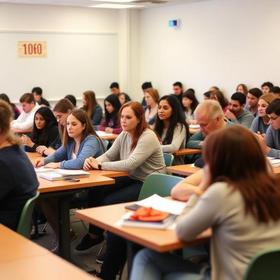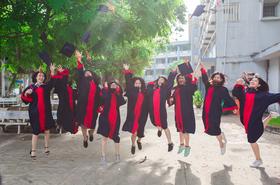- Goodwin University is a private university in East Hartford, Connecticut, United States. It was founded in 1962 as the Data Institute Business School. It purchased the University of Bridgeport in January 2021.
School Highlights
Goodwin University serves 4,962 students (21% of students are full-time).
The college's student-teacher ratio of 12:1 is lower than the state community college average of 26:1.
Minority enrollment is 61% of the student body (majority Black and Hispanic), which is less than the state average of 72%.
Quick Facts (2026)
- Enrollment: 4,962 students
- Private-state tuition: $19,450
- Student-teacher ratio: 12:1
- Minority enrollment: 61%
- Source: Integrated Postsecondary Education Data System (IPEDS)
Top Rankings
Goodwin University ranks among the top 20% of public schools in Connecticut for:
Category
Attribute
School Resources
Community Size
School Overview
The teacher population of 408 teachers has stayed relatively flat over five years.
Goodwin University
(CT) Community College Avg.
Carnegie Classification
Baccalaureate/Associate's Colleges: Mixed Baccalaureate/Associate's
Associates Colleges
Institution Level
Four or more years
Four or more years
Institution Control
Private not-for-profit
Public
Total Faculty
408 staff
154 staff
School Calendar
Student Body
The student population of Goodwin University has grown by 49% over five years.
The student-teacher ratio of 12:1 has decreased from 21:1 over five years.
The Goodwin University diversity score of 0.71 is less than the state average of 0.81. The school's diversity has grown by 20% over five years.
Total Enrollment
4,962 students
1,483 students
Student-Teacher Ratio
12:1
26:1
# Full-Time Students
1,041 students
770 students
# Part-Time Students
3,921 students
713 students
# Enrollment Undergraduate
479 students
352 students
# Full-Time Undergraduate Students
1,014 students
770 students
# Full-Time Graduate Students
27 students
27 students
# Part-Time Undergraduate Students
3,777 students
1,218 students
# Part-Time Graduate Students
144 students
144 students
Total Dormitory Capacity
n/a
550 students
% American Indian/Alaskan
1%
2%
% Asian
3%
9%
% Hispanic
25%
17%
% Black
26%
20%
% White
39%
28%
% Hawaiian
n/a
17%
% Two or more races
4%
3%
% Non Resident races
n/a
2%
% Unknown races
2%
2%
Diversity Score
0.71
0.81
College Completion Rate (Students who graduate in less than 4 years)
27%
10%
College Completion Rate (Students who graduate in 4 years or more than 4 years)
48%
60%
Average Graduate Earnings (10 Years)
$30,100
$34,800
Tuition and Acceptance Rate
The private state tuition of $19,450 is less than the state average of $21,887. The private state tuition has declined by 7% over four years.
Private State Tuition Fees
$19,450
$21,887
Tuition Notes
$9,994/semester
% Students Receiving Some Financial Aid
99%
88%
Median Debt for Graduates
$31,096
$8,000
Median Debt for Dropouts
$9,500
$4,356
Acceptance Rate
n/a
78%
SAT Reading
n/a
500
SAT Math
n/a
510
ACT Composite
n/a
23
Source: 2024 (or latest year available) Integrated Postsecondary Education Data System (IPEDS)
Frequently Asked Questions
How much does Goodwin University cost?
Goodwin University's private state tuition is approximately $19,450.
What is Goodwin University's ranking?
Goodwin University ranks among the top 20% of community college in Connecticut for: Percent of students receiving financial aid and Largest student body.
Recent Articles

Part-Time vs. Full-Time Enrollment in 2025: Which Is Better?
Explore part-time vs. full-time enrollment in 2025, comparing costs, flexibility, outcomes, and goals to help students choose the right path.

How Community Colleges Use AI Tools to Support Student Success
Explore how community colleges are using AI tools in 2025 to improve advising, learning, retention, and student success.

Nontraditional Student’s Guide to Community College 2025
Comprehensive guide for nontraditional students at community college with updated tuition, support, careers, and success strategies for 2025.









